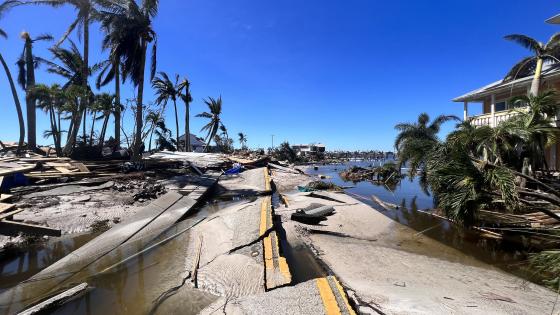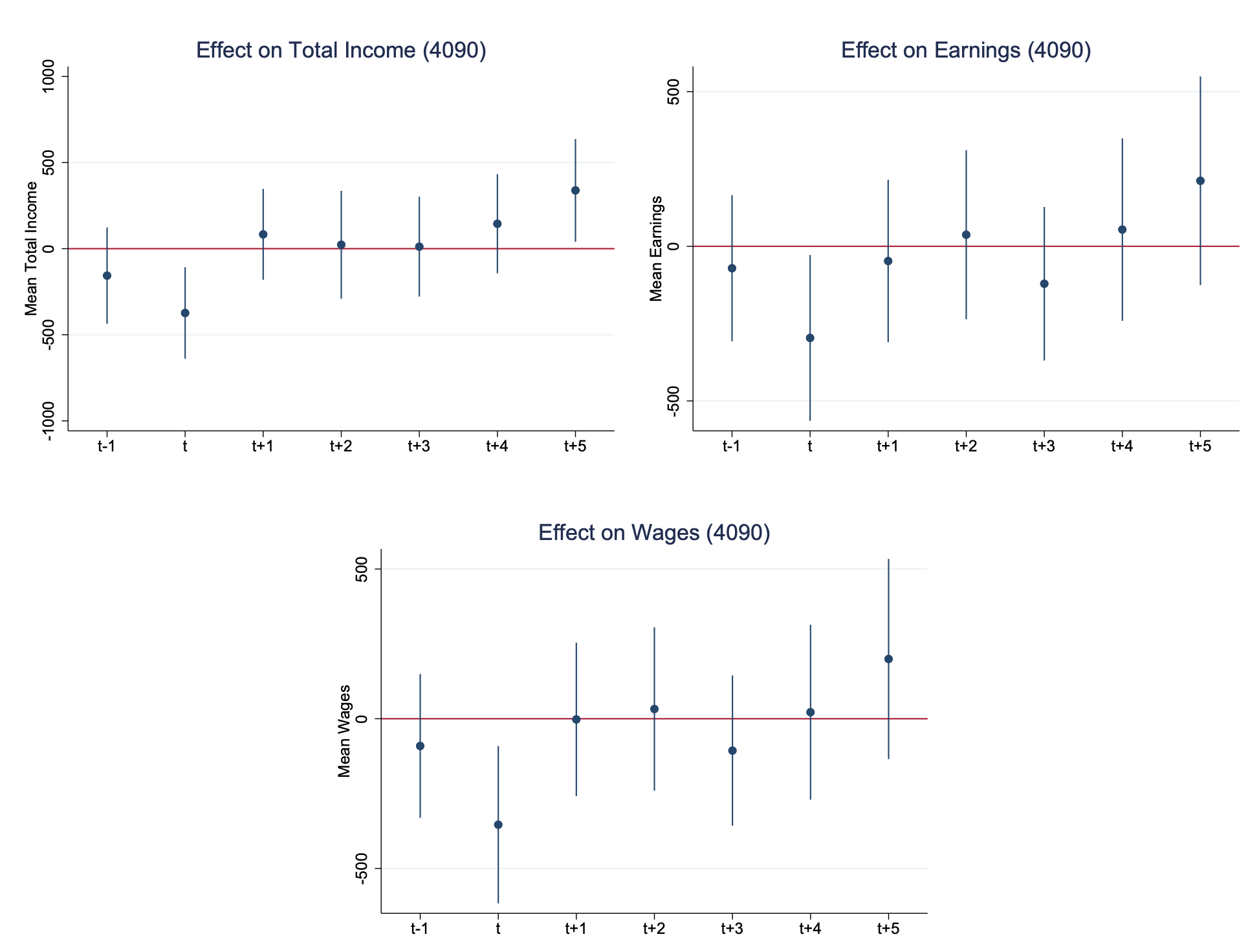Natural disasters have short- and long-term effects on the economy as well as people’s lives. For example, weather shocks and the resulting macroeconomic fluctuations cost the economy 0.3% of permanent consumption in New Zealand (Gallic and Vermandel 2020). Direct damages are only a part of the economic burden that natural disasters impose (Noy 2009, 2012). Secondary effects on economic development in the post-disaster period are potentially more severe as reconstruction takes valuable resources from other sectors: a severe natural disaster reduces per capita incomes by 7.4% two decades later, thereby undoing 3.7 years of average development (Hsiang and Jina 2014). This has major implications for countries that are regularly exposed to severe natural disasters. This column documents the results of a study on the effects of natural disasters on income distribution in US counties (Pleninger 2022).
Why study the US?
The US experiences natural disasters frequently, with a variety of types and with a geographic variation. Furthermore, the Federal Emergency Management Agency provides data on disaster declarations at regional, state and county levels that score over geological measures. Declarations rule out inconsequential natural hazards occurring in remote areas and, thus, measure actual impacts.
The coasts and the Midwest have the highest numbers of disaster declarations (Figure 1, top panel). On the east and gulf coasts, coastal storms, such as hurricanes, are the most common declared disasters (Figure 2, bottom panel). The most frequent disaster in the Midwest is heavy storms. Droughts and wildfires are mainly reported in the West. Disasters are usually declared in multiple counties, and one county tends to have multiple disaster declarations per year and for different types.
Figure 1 Disaster count and disaster type
Note: The top map shows the total number of disasters for each county from 1996-2017. Darker red indicates a higher number of disasters. The bottom map shows the spatial distribution of the most frequent natural disasters, calculated at the county level. Each type of disaster is denoted in a different colour.
Different types of income
In order to estimate the effect of natural disasters on income distribution, I use the Current Population Survey (CPS) from 1996¬ to 2017, which provides different income definitions. Total income consists of labour and capital income, whereas labour income can be further divided into earnings and transfer income.
Each type of income can be defined at the individual or the household level. Due to the wider availability, the literature usually relies on household-based measures of income inequality that neglect intra-household inequality between two spouses. In contrast, individual-based measures are likely to overestimate overall inequality, as household members tend to share at least part of their income within their family. Using both measures provide upper and lower bounds of the true effects.
Using CPS income data, I partition all incomes at the county level into three groups, namely bottom, middle and top, to estimate the effects on the entire income distribution. The bottom-income group encompasses the bottom 40% of income earners. In contrast, the top-income group includes individuals or households with the highest 10% incomes.
Middle-class incomes are affected
The results suggest significant negative effects of natural disasters on middle-class incomes. The effect is particularly strong for individual-based measures. Income smoothing within the household seems to absorb some of the effects. Observing the effects over time, Figure 2 suggests that the impact is short-term in nature. It is significantly negative in the year of the disaster but becomes insignificant years after. In addition, the effect is driven by earnings (top-right graph) and, in particular, by wages (bottom graph). There is no significant effect of natural disasters on the incomes of the bottom 40% or top 10%. However, there is a negative effect on the capital income of the top 10%. Since capital income constitutes only a small portion of total income, even for the top income group, the effects do not appear in the total income results.
Figure 2 Long-term effects on middle incomes
Note: The graph shows the effects of natural disasters on individual-based middle incomes over time. t denotes the year in which at least one disaster occurred. Total income (top-left graph) consists of capital and labour income. The latter is further divided into earnings (top-right graph) and transfers. Earnings include wages (bottom graph), salaries and income from self-employment (e.g. farm income, business income). The effects are estimated using population-weighted fixed effects regression with standard errors clustered at the county level. Confidence intervals are on the 10%-level.
Does migration matter?
Counties hit by severe disasters experienced larger out-migration, lower home prices and higher poverty rates (Boustan et al. 2020). Several studies report that natural disasters and climate change have implications for population size, families’ location choices, and business sector development (Hornbeck 2012; Coffman and Noy 2012; Kahn 2010). The CPS data shows that 4% of the sample population moved within the analysed time frame of this study. However, less than 1% report natural disasters as the primary reason for their move. Most movers report job, family, or housing as their primary reason. Since large and selective migration flows can have an effect on income distribution, there is reason to believe that migration rather than natural disasters are affecting incomes. Therefore, a sample that places movers back to their original locations is constructed to calculate income inequality measures based on these reassigned incomes. These synthetic measures represent income inequality in the absence of migration. After controlling for migration, the main results still hold, suggesting that the effects of natural disasters on incomes are not biased by migration.
Adaptation helps, but intensification does not
One important adaptation tool is unemployment insurance, which supports individuals in times of financial hardship. Natural disasters have no contemporaneous effect on unemployment benefits. However, benefits increase significantly one year after a disaster. This time lag in benefit payments is one explanation for the contemporaneous negative effect of natural disasters on earnings. Hence, adaptation is important to circumvent some of the effects. This can also be observed when studying the effects of disasters for counties that experienced zero to four disasters in the last five years. Figure 3 shows the effects of natural disasters on total income (top-left graph), middle-class earnings (top-right graph) and top 10% earnings (bottom graph) for a given number of recent disasters (x-axis). The effect is strongly negative in counties that experienced no disaster in the last five years. But there are no statistically significant effects on incomes in counties with one or two previous disasters. Lastly, the effect on middle-class earnings (top-right graph) becomes increasingly negative as the number of disasters accumulates.
Figure 3 Impact of previous disasters
Note: The graph shows the marginal effects of natural disasters on individual-based income measures (respective y-axes) for different numbers of previous disasters (x-axes). Each dot denotes the total effect of natural disasters on the respective variable on the y-axis. The dot for five previous disasters is excluded because the standard errors are too large to give a meaningful interpretation. Whiskers show 90% confidence intervals.
Policy implications
The increase in the frequency and severity poses a challenge for local, state, and federal governments to deal with the aftermath of disasters. First, income inequality levels are already high in the US compared to other OECD countries: the Gini coefficient for the US is above 40, compared with the UK, Canada, and Germany, where it is in the lower 30s (World Development Indicators 2022).
Due to the initially higher inequality levels, additional stress on the income distribution is likely to trigger social discontent. Second, the strong effect on middle-class incomes suggests that this income group is not adequately protected by insurance and other benefits to cushion the effects. Lastly, counties that have no experience with natural disasters ex-ante tend to be more affected, suggesting that adaptation policies work and, thus, should be more widely implemented. For instance, increasing the speed of unemployment benefits payments might cushion some of the financial strains experienced in the year of the disaster.
References
Boustan, L P, M E Kahn, P W Rhode and M L Yanguas (2020), “The effect of natural disasters on economic activity in US counties: A century of data”, Journal of Urban Economics 118: 103257.
Coffman, M and I Noy (2012), “Hurricane Iniki: measuring the long-term economic impact of a natural disaster using synthetic control”, Environment and Development Economics 17(2): 187-205.
Gallic, E and G Vermandel (2020), “Weather shocks”, European Economic Review 124: 103409.
Hornbeck, R (2012), “The enduring impact of the American Dust Bowl: Short-and long-run adjustments to environmental catastrophe”, American Economic Review 102(4): 1477-1507.
Hsiang, S M and A S Jina (2014), “The Causal Effect of Environmental Catastrophe on Long-Run Economic Growth: Evidence from 6,700 Cyclones”, NBER Working Paper No. 20452.
Kahn, M (2010), “Climatopolis: How will climate change impact urbanites and their cities?”, VoxEU.org, 11 September.
Noy, I (2012), “The enduring economic aftermath of natural catastrophes”, VoxEU.org, 5 September.
Noy, I (2009), “The macroeconomic consequences of disasters”, Journal of Development Economics 88(2): 221-231.
Pleninger, R (2022), “Impact of Natural Disasters on the Income Distribution”, World Development 157: 105936.






